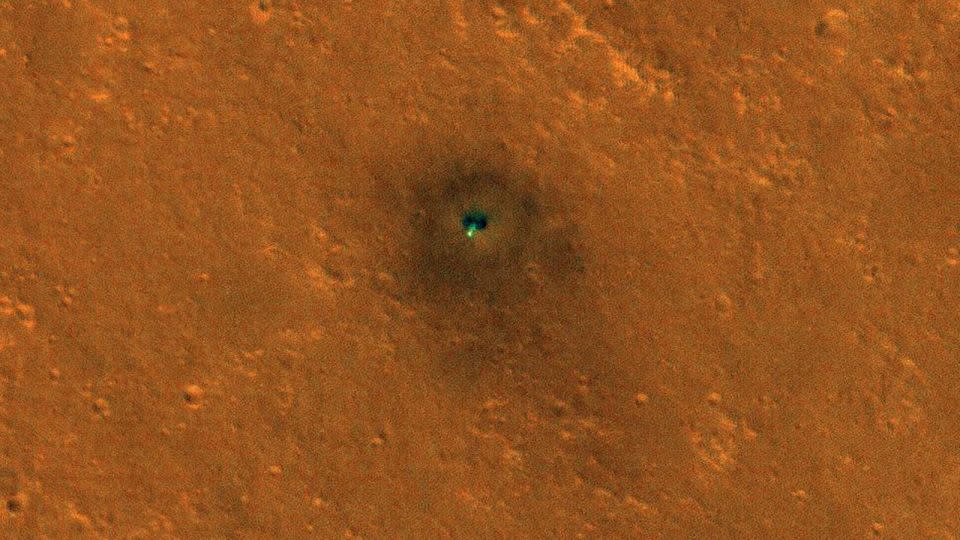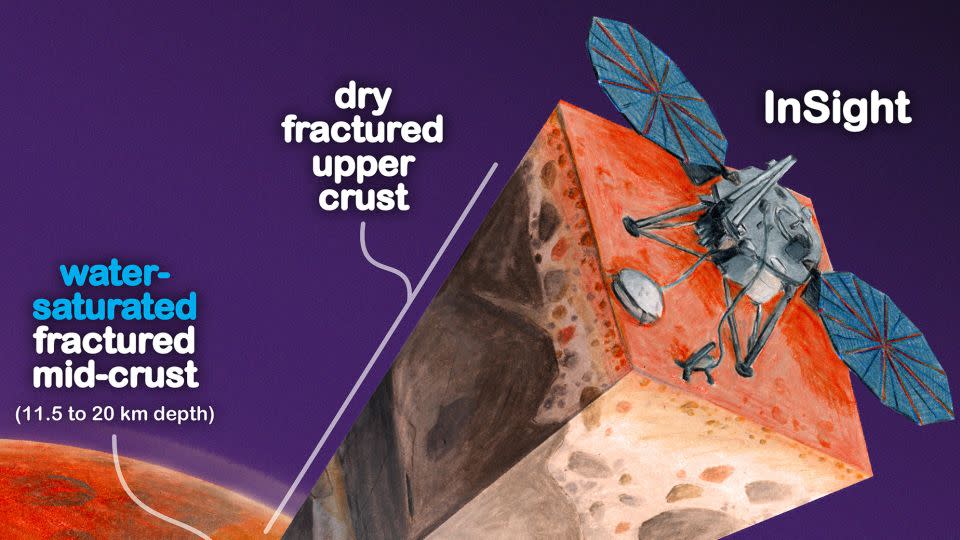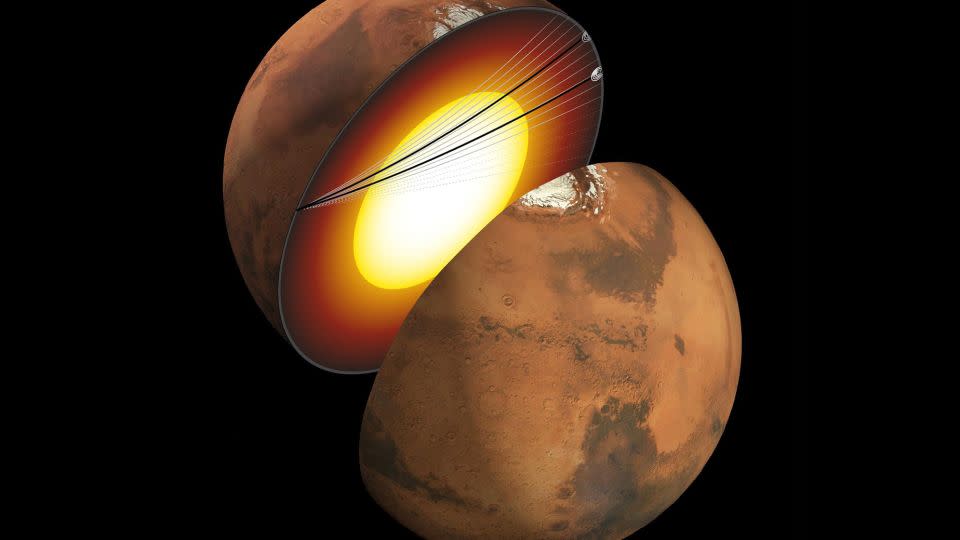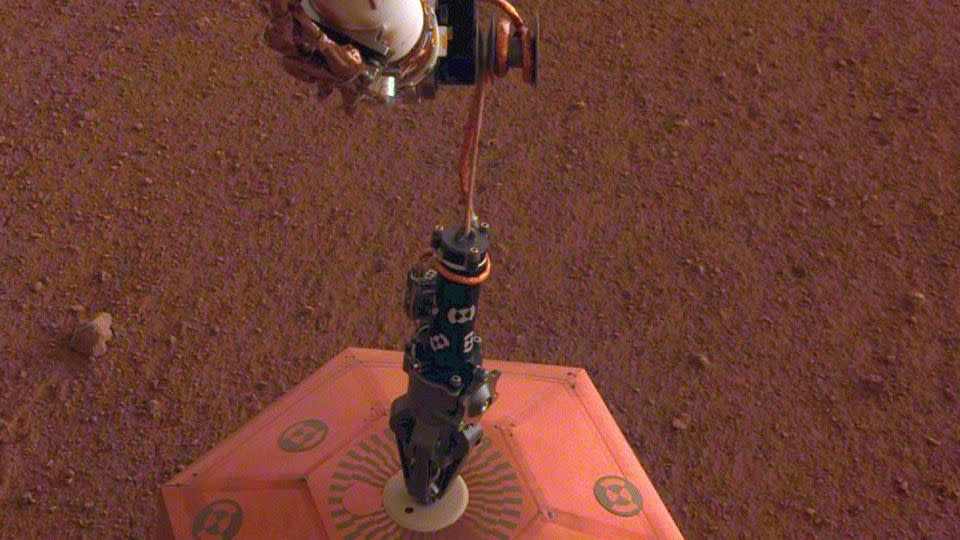Sign up for CNN’s Wonder Theory science newsletter. Explore the universe with news about fascinating discoveries, scientific developments and more.
New research shows that data from a retired NASA mission provides evidence of an underground water reservoir deep beneath the surface of Mars.
A team of scientists estimates that there could be enough water trapped in tiny cracks and pores in the rock at the center of the Martian crust to fill oceans on the planet’s surface. The groundwater would likely cover all of Mars to a depth of 1 mile (1.6 kilometers), the study found.
The data comes from NASA’s InSight lander, which used a seismometer to study the interior of Mars from 2018 to 2022.
Future astronauts exploring Mars will face a host of challenges trying to reach the water, which is between 7 and 12 miles (11.5 and 20 kilometers) below the surface, according to a study published Monday in the journal Proceedings of the National Academy of Sciences.
But the find reveals new details about the geological history of Mars, and suggests a new place to look for life on the Red Planet if water ever becomes accessible.

“Understanding the water cycle on Mars is critical to understanding the evolution of the climate, surface and interior,” lead study author Vashan Wright, an assistant professor and geophysicist at the Scripps Institution of Oceanography at the University of California, San Diego, said in a statement. “A useful starting point is to identify where water is and how much there is.”
The search for ‘lost’ water on Mars
Mars was likely a warmer, wetter place billions of years ago, based on evidence of ancient lakes, riverbeds, deltas and rocks altered by water studied by other NASA missions and observed by orbiters. But the Red Planet lost its atmosphere more than 3 billion years ago, effectively ending Mars’ wet period.
Scientists still aren’t sure why Mars lost its atmosphere, and numerous missions have been developed to learn more about the history of water on the planet, where it went, and whether water ever created conditions for life on Mars. Although water is trapped as ice on the planet’s polar caps, researchers don’t believe that can explain all of the planet’s “lost” water.
Existing theories offer a number of likely scenarios for what happened to the water on Mars after it lost its atmosphere. Some theories suggest that the water became ice or was lost to space, while others suggest that it was incorporated into minerals beneath the planet’s surface or found its way into deep water layers.
The new findings suggest that water on Mars seeped into the Martian crust.
InSight, short for Interior Exploration using Seismic Investigations, Geodesy and Heat Transport, was a stationary lander. But it collected unprecedented data on the thickness of the Red Planet’s crust and the temperature of its mantle, as well as the depth and composition of its core and atmosphere. The lander’s seismometer detected the first earthquakes on another planet, known as marsquakes.
While earthquakes occur when tectonic plates slide, move and grind against each other, the Martian crust is like one big plate with cracks and fractures as the planet continues to shrink and cool over time. As the Martian crust stretches, it cracks, and InSight’s seismometer has detected more than 1,300 marsquakes as they rumble from hundreds and thousands of miles away.
Scientists studying InSight data were able to study the speed of Marsquakes as they traveled across the planet, which could serve as an indicator of what materials are beneath the Martian surface.
The speed of seismic waves depends on the composition of the rock, where the cracks are and what those cracks are filled with, Wright said.
The team took this data and fed it into a mathematical model of rock physics, which is used on Earth to map underground oil fields and aquifers.
The results showed that InSight’s data best matched a thick layer of igneous, or volcanic, rock filled with liquid water.


“Finding that there is a large reservoir of liquid water provides a glimpse into what the climate was or might have been like,” study co-author Michael Manga, a professor of earth and planetary sciences at the University of California, Berkeley, said in a statement.
“And water is necessary for life as we know it. I don’t see why (the underground reservoir) isn’t a habitable environment,” Manga added. “It’s certainly true on Earth — deep, deep mines have life, the bottom of the ocean has life. We haven’t found evidence of life on Mars, but we’ve identified a place that could potentially support life.”
If the Martian crust is the same across the planet, there may be more water in the middle crust zone than the “volumes thought to have filled the hypothesized ancient Martian oceans,” the authors wrote in the study.
According to Wright, rocks contain information about a planet’s history. By understanding a planet’s water cycle, researchers can better understand the evolution of Mars.
While analysis of the data cannot provide information about life, past or present, if it exists on Mars, it is possible that the wet Martian crust could be habitable, in the same way that deep groundwater on Earth is suitable for microbial life, he said.
But even drilling holes just a kilometer or deeper on Earth is a challenge that requires energy and infrastructure. That’s why drilling to such depths would require huge amounts of raw materials to Mars, Wright said.


The team was surprised to find no evidence of a layer of frozen groundwater beneath Insight, because that part of the crust is cold. The researchers are still trying to figure out why there is no frozen groundwater at shallower depths above the mid-crust.
Windows on the History of Mars
The findings provide a new piece of the water puzzle on Mars.
The idea that liquid water could exist deep beneath the surface of Mars has been around for decades, but this is the first time that real data from a Mars mission can confirm such speculation, said Alberto Fairén, a visiting interdisciplinary planetary scientist and astrobiologist in the astronomy department at Cornell University. Fairén was not involved in the study.
He said the water is likely “some kind of deep underground mud.”
“These new results show that liquid water exists in the Martian subsurface today, not in the form of discrete and isolated lakes, but as liquid, water-saturated sediments, or aquifers,” Fairén said. “On Earth, the subsurface biosphere is truly vast, containing most of the prokaryotic diversity and biomass on our planet. Some studies even point to an origin of life on Earth precisely deep in the subsurface. Therefore, the astrobiological implications of finally confirming the existence of liquid water habitats kilometers below the Martian surface are truly exciting.”


The result is “exactly the kind of thing I was hoping we would get out of InSight,” said Bruce Banerdt, the principal investigator of the InSight mission.
“I was hoping that we would get good enough data to do these kinds of studies, where we’re actually looking at details of the interior of Mars that are relevant to geological questions, questions about the habitability of Mars, questions about the evolution of Mars,” he said.
Banerdt, who was not involved in the study, said that while the interpretation of the data presented in the paper is strongly supported by good arguments, he also believes it is still somewhat speculative and that there is almost always another way to explain a given set of data.
“I was really impressed that Wright et al. used concepts from mineral physics to interpret seismic data,” said Banerdt.
Banerdt and Wright both expressed interest in the possibility of sending more seismometers to Mars and other planets and moons in our solar system in the future. While InSight’s single seismometer collected crucial data, spreading it out across Mars would reveal variations in the planet’s interior and provide a larger window into its diverse and complex history, Banerdt said.
“Just as on Earth, where groundwater is connected to the surface through rivers and lakes, this was certainly the case on early Mars,” Wright said. “The groundwater we see is a record of that past.”
For more CNN news and newsletters, create an account at CNN.com